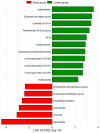Insights into Gut Microbiome Composition in Hidradenitis Suppurativa: A Comprehensive Examination of Dietary Habits and Environmental Influences
- PMID: 38892709
- PMCID: PMC11174550
- DOI: 10.3390/nu16111776
Insights into Gut Microbiome Composition in Hidradenitis Suppurativa: A Comprehensive Examination of Dietary Habits and Environmental Influences
Abstract
This study explores the relationship between dietary habits, environmental influences, and gut microbiome composition in individuals with hidradenitis suppurativa (HS), a chronic inflammatory skin condition. A cohort of 80 participants, equally divided into HS patients and healthy controls, was assessed through comprehensive questionnaires capturing demographics, dietary habits, and other health-related information. Fecal samples were collected and analyzed using next-generation sequencing to examine microbiome composition. Despite previous studies suggesting gut dysbiosis in HS, this research found no significant differences in alpha-diversity and Shannon diversity index between the groups. However, significant disparities in dietary habits were observed, with HS patients showing higher sugar and milk consumption. The study also identified a significant correlation between coffee consumption and the presence of certain bacterial genera. While the study did not reveal major differences in microbiome diversity, the findings on dietary habits and specific microbiome components suggest potential targets for therapeutic intervention. These results underscore the importance of further research into the gut-skin axis and its role in HS, aiming to enhance management strategies through dietary modifications and lifestyle interventions.
Keywords: diet; dietary modifications; gut microbiota; gut–skin axis; hidradenitis suppurativa.
Conflict of interest statement
The authors declare no conflicts of interest. The funder had no role in the design, data collection, data analysis, and reporting of this study.
Figures
Similar articles
-
Altered Skin and Gut Microbiome in Hidradenitis Suppurativa.J Invest Dermatol. 2022 Feb;142(2):459-468.e15. doi: 10.1016/j.jid.2021.05.036. Epub 2021 Aug 6. J Invest Dermatol. 2022. PMID: 34364884
-
Microbiome Perturbations in Hidradenitis Suppurativa.Dermatol Clin. 2025 Apr;43(2):193-202. doi: 10.1016/j.det.2024.12.005. Epub 2025 Jan 21. Dermatol Clin. 2025. PMID: 40023621 Review.
-
Follicular Skin Disorders, Inflammatory Bowel Disease, and the Microbiome: A Systematic Review.Int J Mol Sci. 2024 Sep 23;25(18):10203. doi: 10.3390/ijms251810203. Int J Mol Sci. 2024. PMID: 39337688 Free PMC article.
-
A microbiome study to explore the gut-skin axis in hidradenitis suppurativa.J Dermatol Sci. 2021 Mar;101(3):218-220. doi: 10.1016/j.jdermsci.2020.12.008. Epub 2021 Jan 5. J Dermatol Sci. 2021. PMID: 33423845 No abstract available.
-
The Follicular Skin Microbiome in Patients With Hidradenitis Suppurativa and Healthy Controls.JAMA Dermatol. 2017 Sep 1;153(9):897-905. doi: 10.1001/jamadermatol.2017.0904. JAMA Dermatol. 2017. PMID: 28538949 Free PMC article.
References
-
- Zouboulis C.C., Desai N., Emtestam L., Hunger R.E., Ioannides D., Juhász I., Lapins J., Matusiak L., Prens E.P., Revuz J., et al. European S1 guideline for the treatment of hidradenitis suppurativa/acne inversa. J. Eur. Acad. Dermatol. Venereol. 2015;29:619–644. doi: 10.1111/jdv.12966. - DOI - PubMed
-
- Zouboulis C.C., Desai N. Hidradenitis suppurativa: A disease of the absent sebaceous gland? J. Investig. Dermatol. 2018;138:1465–1467. - PubMed
-
- Jfri A.H., Alharthi S.A., Al-Saif F. The role of cytokines in the pathogenesis of hidradenitis suppurativa. J. Inflamm. Res. 2019;12:165–175.
-
- Smith J.K., Jones A.B., Johnson C.D. The impact of obesity on hidradenitis suppurativa. J. Dermatol. Sci. 2018;10:123–135.
MeSH terms
Grants and funding
LinkOut - more resources
Full Text Sources
Medical




